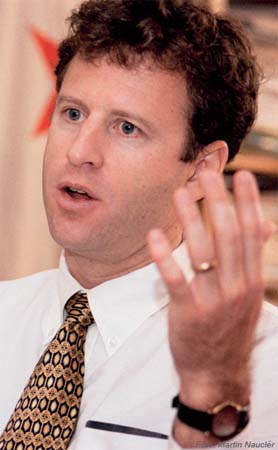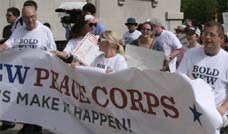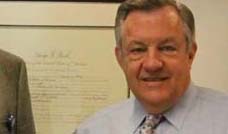
"The administration is hardly slashing funds for defense; it is simply adopting a policy of zero real growth in the "base budget" (the part that does not include war costs, which are too unpredictable to include in this analysis). Specifically, the base budget is to grow 2 percent a year over the next five years. But with the inflation rate expected to average over 1.5 percent, the net effect is essentially no real growth. Cumulatively, that would leave us about $150 billion short of actual funding requirements through 2014. The administration is right to propose increasing resources for the State Department and aid programs. But it is unwise politics and unwise strategy to put these key elements of foreign policy in direct competition with each other, as appears to be the case in the new budget." Michael O'Hanlon, a Senior Fellow at the Brookings Institute and a Visiting Lecturer at Princeton University, served as a Peace Corps Volunteer in Congo Kinshasa.
Michael O'Hanlon writes: Obama's first big mistake
Michael O'Hanlon: Obama's first big mistake
by Michael O'Hanlon - Jun. 10, 2009 09:55 AM
Special to The Washington Post
After three months of very impressive decisions regarding national security, President Obama made perhaps his first significant mistake. It concerns the defense budget, where his plans are insufficient to support the national security establishment over the next five years. Thankfully, this mistake can be fixed before it causes big harm - either by Congress this year or the administration itself next year.
The administration is hardly slashing funds for defense; it is simply adopting a policy of zero real growth in the "base budget" (the part that does not include war costs, which are too unpredictable to include in this analysis). Specifically, the base budget is to grow 2 percent a year over the next five years. But with the inflation rate expected to average over 1.5 percent, the net effect is essentially no real growth. Cumulatively, that would leave us about $150 billion short of actual funding requirements through 2014. The administration is right to propose increasing resources for the State Department and aid programs. But it is unwise politics and unwise strategy to put these key elements of foreign policy in direct competition with each other, as appears to be the case in the new budget.
For the Defense Department to merely tread water, a good rule of thumb is that its inflation-adjusted budget must grow about 2 percent a year (roughly $10 billion annually, each and every year). Simply put, the costs of holding on to good people, providing them with health care and other benefits, keeping equipment functional, maintaining training regimes, and buying increasingly complex equipment tend to grow faster than inflation. This is, of course, no more an absolute rule than is Moore's law about changes in computing capacity. But like Moore's law, it tends to hold up remarkably well with time, especially when downsizing the Defense Department's force structure is not really an option, and it is not today.
It is easiest to understand this by examining the four main categories of Pentagon spending: military personnel, operations and maintenance, procurement, and research and development. Regarding the first, there were times in the 1970s when we starved personnel accounts, but the result was a dispirited and "hollow" force. At a time of war, when we are asking so few troops to do so much for so long, this is not a viable option. In fact, over the years of the Bush presidency, personnel spending increased 100 percent. About 25 percent of that was due to the cumulative effects of inflation and another quarter to mobilizing reservists and enlarging the force. But the remaining half was real cost growth averaging 5 percent a year. Even if we slow the trend, we can't realistically end it.
Operations and maintenance costs are always what budgeteers want to cut - and always the area where they overestimate the potential for savings. This was the case in the 1990s; almost every year the Clinton administration hoped to economize on such expenses through new types of efficiencies, but almost every year it wound up needing to add to those accounts retroactively. Among defense budget specialists, the real debate is whether inflation-adjusted operations and maintenance costs per person grow at 2 percent annually or 3 percent or somewhere in between.
Procurement and research and development are the chief areas in which Defense Secretary Robert Gates has sought savings in the proposals he announced in April. He has proposed cuts to programs including the F-22 fighter, the DDG-1000 destroyer, the Army's Future Combat System, the presidential helicopter fleet, the transformational communications satellite, aircraft carrier production runs, the airborne laser missile defense program and the next-generation bomber. These are solid proposals; he could make additional cuts to the V-22 Osprey and the F-35 Joint Strike Fighter programs, as well as existing nuclear weapons platforms.
It is important to note, though, that these aren't cuts in current costs; they are cuts in plans. When you eliminate a defense program, you still typically must buy something to replace aging equipment, even if the alternative is less expensive. Moreover, a lot of equipment (much of it purchased under Ronald Reagan and the first President Bush) is wearing out, and we need to replace it soon. Making greater use of service-life extension programs, modifications to existing weapons, and inexpensive but high-performance modern technologies such as advanced munitions and robotics can keep a check on cost growth. But these steps can't freeze costs.
Putting all of this together, the Congressional Budget Office has estimated that real defense spending would have to be about 10 percent greater than today over roughly the next decade to afford what is on the Pentagon's books. The CBO has not recalculated in light of Gates' plans, but a rough estimate suggests the need for 7 to 8 percent higher spending for an average year in the future. That is another way of saying that we need roughly 2 percent real growth per year, while Obama offers zero. By 2014, this amounts to a difference of about $50 billion in the annual budget, and a cumulative five-year discrepancy of about $150 billion. Once increased, defense spending would still decline as a fraction of gross domestic product, but not as much as is currently forecast. The plan will have to change. The question is whether we do it now or do it later.
Michael O'Hanlon, a senior fellow at the Brookings Institution and a former analyst at the Congressional Budget Office, is the author of the new book "Budgeting for Hard Power."












